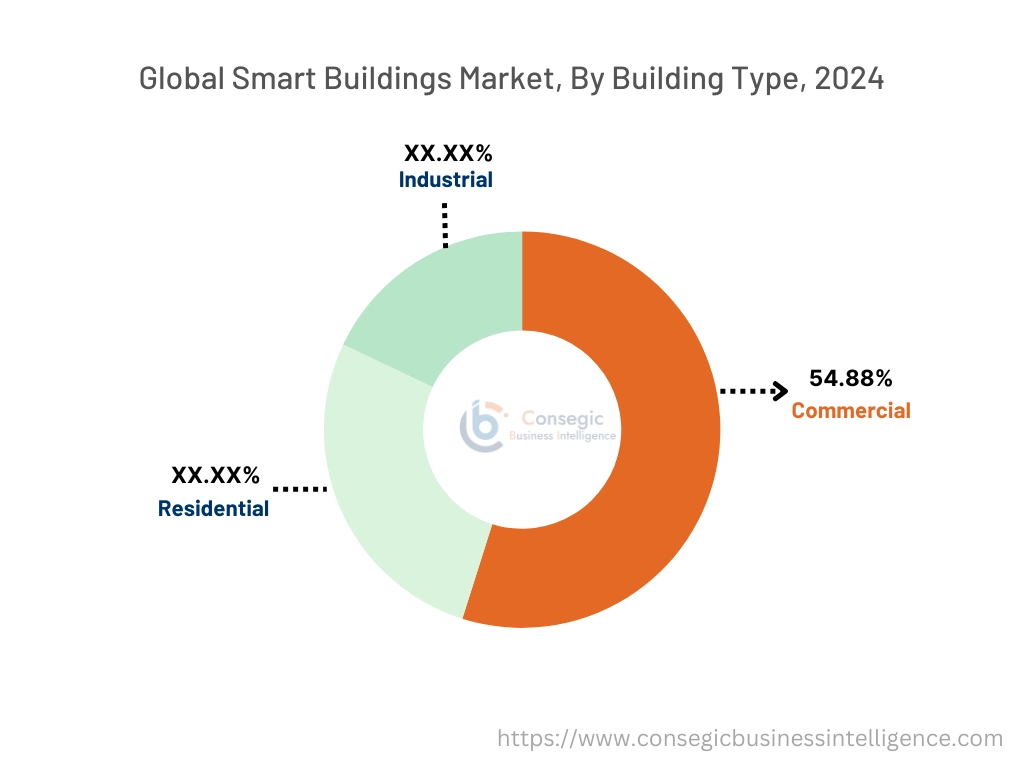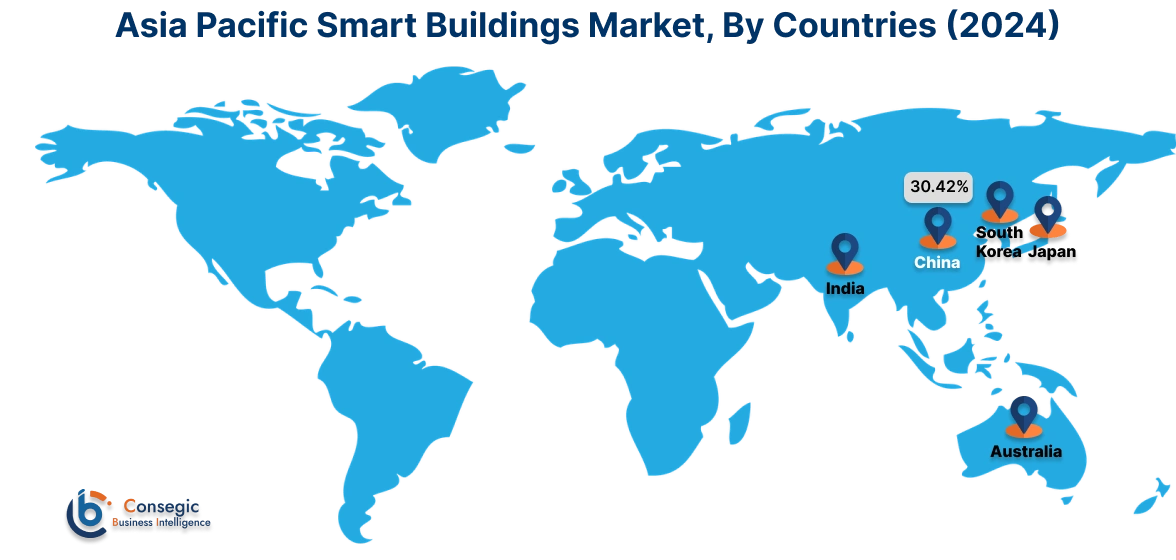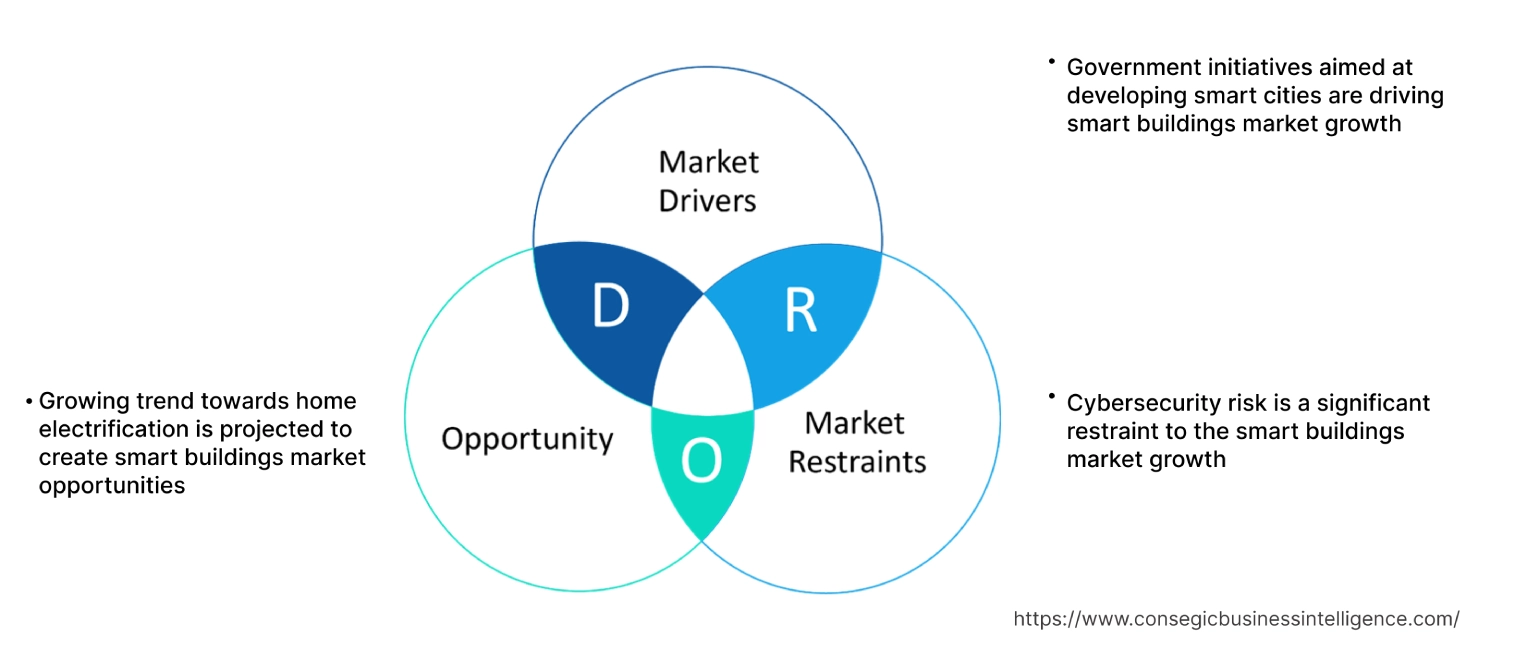- Summary
- Table Of Content
- Methodology
Smart Buildings Market Size:
Smart Buildings Market Size is estimated to reach over USD 439.61 Billion by 2032 from a value of USD 113.93 Billion in 2024 and is projected to grow by USD 132.90 Billion in 2025, growing at a CAGR of 20.6% from 2025 to 2032.
Smart Buildings Market Scope & Overview:
Smart buildings are structures that utilize advanced technologies to optimize various aspects of building operation, occupant comfort, and resource efficiency. These buildings integrate systems like heating, ventilation, air conditioning (HVAC), lighting, security, and energy management through interconnected networks of sensors, software, and automation. By collecting and analyzing real-time data, smart buildings adapt to changing conditions, improve energy consumption, enhance occupant experiences, and streamline building management.
Key Drivers:
Government initiatives aimed at developing smart cities are driving smart buildings market growth
Smart city projects involve the development of integrated infrastructure, where buildings are connected to city-wide networks. This encourages the adoption of smart building technologies that can communicate and interact with other urban systems. Additionally, governments are increasingly implementing policies and regulations that promote energy efficiency and sustainability in buildings, creating a favorable environment for the adoption of smart building technologies, hence boosting the smart buildings market trend.
- For instance, India's Smart Cities Mission (SCM) is transforming urban living by implementing smart and sustainable solutions across 100 cities. With a substantial investment of ₹1,47,704 crore, the mission has successfully completed 7,380 out of 8,075 projects, focusing on enhancing infrastructure, governance, and social development to create economically vibrant, inclusive, and environmentally friendly cities.
Consequently, increasing government initiatives aimed at developing smart cities is driving the smart buildings market expansion.
Key Restraints:
Cybersecurity risk is a significant restraint to the smart buildings market growth
Smart buildings rely on interconnected devices and systems, creating a vast attack surface for cybercriminals. Each connected sensor, HVAC system, lighting control, and security camera represents a potential entry point. Additionally, smart buildings collect and process vast amounts of sensitive data, including occupant information, building access logs, and operational data, which is vulnerable to breaches and misuse. Moreover, many existing buildings are being retrofitted with smart technologies, and these systems may not have been designed with modern cybersecurity, thereby restraining the global smart buildings market size.
Therefore, as per the analysis, these combined factors are significantly hindering smart buildings market expansion.
Future Opportunities :
Growing trend towards home electrification is projected to create smart buildings market opportunities
Growing trend towards the transition from fossil fuels to electricity for heating, cooling, and appliances, is raising the need for efficient energy management. Smart building technologies, such as smart thermostats, energy monitoring systems, and load balancing tools, will be crucial for optimizing energy consumption. Additionally, home electrification is expected to increase the demand for electricity, putting strain on existing grids. Smart buildings can play a vital role in demand response programs, where homes reduce their energy consumption during peak hours, thus boosting the smart buildings market demand.
- For instance, in Feb 2025, ABB introduced the ReliaHome Smart Panel, a groundbreaking electrical load management system featuring Panel Guard technology, designed to optimize energy usage in all-electric homes. This system, controlled via a mobile app, ensures homes remain within their electrical capacity, enhancing efficiency.
Hence, based on the analysis, growing trend towards home electrification is expected to create smart buildings market opportunities.
Smart Buildings Market Segmental Analysis :
By Component:
Based on the component, the market is categorized into solution and services.
Trends in the Component:
- Growing trend towards the adoption of cloud-based models, offering enhanced scalability, flexibility, and remote management capabilities.
- Integrated Workplace Management Systems (IWMS) are gaining traction, providing a centralized platform to manage various building functions, including space utilization, energy management, and maintenance.
Solution accounted for the largest revenue share in the market in 2024.
- The smart buildings market share is expanding due to the increasing adoption of biometric authentication and mobile access solutions, which replace traditional keycards with smartphone credentials.
- Additionally, fire and life safety systems are becoming integrated with other building systems, enabling intelligent responses to emergencies.
- Moreover, the adoption of AI-driven video analytics is transforming video surveillance. AI algorithms analyze footage in real-time to detect anomalies, identify individuals, and provide valuable insights.
- For instance, in 2023, TMA Solutions released T-Cam Edge AI Surveillance, an advanced security and facility management solution for smart buildings. This system utilizes edge AI to provide real-time monitoring, including alerts for unauthorized entry into restricted zones and notifications regarding the presence of blacklisted individuals, thereby significantly enhancing security protocols.
- Thus, as per the smart buildings market analysis, the aforementioned factors are driving the solution segment.
Services is predicted to register the fastest CAGR during the forecast period.
- Specialized services are emerging to assess vulnerabilities, implement robust security measures, and provide ongoing monitoring to protect building systems and data, thereby driving the smart buildings market share.
- The smart buildings market size is growing, driven by the necessity for integration services that ensure seamless operation of diverse building systems (HVAC, lighting, security, etc.).
- Services are increasingly geared towards enhancing the comfort, productivity, and well-being of building occupants. This includes services that support personalized environmental controls, space optimization, and seamless technology integration.
- Consequently, the aforementioned factors are driving the services segment growth during the forecast period.
By Solution Type:
Based on the Solution Type, the market is classified into Building Infrastructure Management (BIM), Security & Emergency Management (SEM), Energy Management, Network Management, Workforce Management, and Waste Management.
Trends in the Solution Type:
- Smart buildings are adopting integrated security systems that combine video surveillance, access control, intrusion detection, and emergency response capabilities.
- Automation of emergency response protocols is enabling faster and more efficient responses to incidents.
Building Infrastructure Management (BIM) accounted for the largest revenue share in 2024.
- Digital twins create virtual replicas of buildings, enabling real-time monitoring, simulation, and optimization of building performance, allowing for predictive maintenance, driving smart buildings market trend.
- BIM is increasingly being integrated with Internet of Things (IoT) sensors and data, providing a more comprehensive understanding of building operations.
- Moreover, BIM plays a crucial role in promoting sustainable building practices by enabling energy analysis, waste reduction, and optimized material selection, which is further driving the smart buildings market demand.
- For instance, in Oct 2024, Autodesk is strengthening its Building Information Modeling (BIM) offerings by focusing on enhanced data connectivity and artificial intelligence.
- Thus, as per the smart buildings market analysis, the aforementioned factors are driving the Building Infrastructure Management (BIM) segment.
Energy Management is predicted to witness the fastest growth during the forecast period.
- Smart building solutions are focused on optimizing energy consumption through advanced control systems, real-time monitoring, and predictive analytics.
- The integration of renewable energy sources, such as solar and wind power, is a key trend in smart building energy management.
- The use of BEMS are becoming more prevalent, with those systems using AI, to optimize energy consumption.
- For instance, in Feb 2025, Kenmore announced to release a new Home Energy Management System, featuring smart devices and an app, to empower homeowners with greater control over their energy consumption. The system, comprising smart plugs, leak detectors, and a central management app, aims to simplify energy efficiency and promote smarter living.
- Therefore, the aforementioned factors are contributing in driving the market growth.
By Building Type:
Based on the building type, the market is categorized into residential, commercial, and industrial.
Trends in Building Type:
- Smart technologies are used to enhance safety through real-time monitoring, hazard detection, and access control in industrial settings.
- Industrial buildings are increasingly automating processes through robotics, IoT devices, and data analytics.
Commercial accounted for the largest revenue share of 54.88% in 2024.
- Smart building technologies, particularly Building Energy Management Systems (BEMS), offer substantial opportunities to optimize energy usage, reduce operational costs, and improve sustainability in commercial buildings.
- Commercial spaces require efficient management of various systems, including HVAC, lighting, security, and space utilization and smart building solutions streamline these operations.
- Moreover, creating comfortable and productive work environments is crucial for attracting and retaining tenants and employees. Smart building technologies enable personalized environmental controls, improved air quality, and seamless connectivity, contributing to a better occupant experience.
- Security systems, including access control, surveillance, and intrusion detection, are essential for protecting commercial spaces.
- In conclusion, the aforementioned benefits are bolstering the global smart buildings market.
Residential are predicted to register the fastest CAGR during the forecast period.
- Homeowners are seeking ways to enhance their comfort and smart home devices such as automated lighting, climate control, and entertainment systems, provide this convenience.
- Rising energy costs and growing environmental awareness are driving demand for smart home solutions that help reduce energy consumption, thus smart thermostats, lighting controls, and energy monitoring systems are becoming increasingly popular.
- In conclusion, the above-mentioned factors are contributing significantly in propelling the market.

Regional Analysis:
The regions covered are North America, Europe, Asia Pacific, the Middle East and Africa, and Latin America.

Asia Pacific region was valued at USD 28.87 Billion in 2024. Moreover, it is projected to grow by USD 33.77 Billion in 2025 and reach over USD 115.09 Billion by 2032. Out of these, China accounted for the largest revenue share of 30.42% in 2024. Governments across the region are investing heavily in smart city initiatives, which include the development of smart buildings. Policies and regulations promoting energy efficiency and sustainability are further driving market growth. Additionally, the presence of key players in the region is also contributing notably in spurring market growth.
- For instance, in March 2024, to accelerate India's building decarbonization efforts, Mahindra Group and Johnson Controls have launched a collaborative Net Zero Buildings Initiative. This partnership aims to provide accessible resources and information, simplifying the path for commercial, residential, and public buildings in India to achieve net-zero emissions.

North America was valued at USD 40.21 Billion in 2024. Moreover, it is projected to grow by USD 46.92 Billion in 2025 and reach over USD 155.80 Billion by 2032.
Increasing stringent energy efficiency regulations and growing awareness of climate change are driving demand for sustainable building solutions. Smart building technologies are being used to optimize energy consumption, reduce carbon emissions, and achieve green building certifications. Additionally, the presence of key players in the region is further driving the smart buildings market.
- For instance, in Dec 2024, Delta is consolidating its North American smart building offerings into Delta Intelligent Building Technologies (DIBT). This new entity combines Delta's various brands, including Amerlux, Delta Electronics, LOYTEC, and March Networks, to provide a comprehensive suite of smart and sustainable solutions.
As per the smart buildings market analysis, Europe's smart building market is driven by stringent sustainability goals, government regulations, and a strong focus on energy efficiency. The region is witnessing significant adoption of Building Energy Management Systems (BEMS), integrated IoT solutions, and smart home technologies. The Latin American smart building market is experiencing gradual growth, fueled by increasing urbanization and the need for infrastructure modernization. Middle East and Africa smart building market is witnessing rapid expansion, driven by ambitious infrastructure projects, government initiatives, and a focus on diversification.
Top Key Players and Market Share Insights:
The market is highly competitive with major players providing smart buildings to the national and international markets. Key players are adopting several strategies in research and development (R&D), product innovation, and end-user launches to hold a strong position in the market. Key players in the smart buildings industry include-
- ABB Group (Switzerland)
- BuildingIQ, Inc. (United States)
- Cisco Systems (United States)
- Delta Electronics (United States)
- Honeywell International (United States)
- IBM Corporation (United States)
- Johnson Controls (Ireland/United States)
- Schneider SE (France)
- Siemens AG (Germany)
- United Technologies Corporation (United States)
Recent Industry Developments :
Partnership:
- In July 2023, Siemens and Prodea Investments partnered to create smart, sustainable buildings in Greece. By integrating Siemens' building technologies, they plan to improve energy efficiency, comfort, and digital connectivity in Prodea's real estate projects.
- In May 2024, ABB Ltd. and Powrmatic formed a partnership to distribute electrical solutions across Canada. By combining ABB's electrical products with Powrmatic's distribution network, they aim to improve accessibility and implementation of reliable electrical systems for residential, commercial, and industrial use, addressing the increasing need for efficient electrical distribution.
Smart Buildings Market Report Insights :
| Report Attributes | Report Details |
| Study Timeline | 2019-2032 |
| Market Size in 2032 | USD 439.61 Billion |
| CAGR (2025-2032) | 20.6% |
| By Component |
|
| By Solution Type |
|
| By Building Type |
|
| By Region |
|
| Key Players |
|
| North America | U.S. Canada Mexico |
| Europe | U.K. Germany France Spain Italy Russia Benelux Rest of Europe |
| APAC | China South Korea Japan India Australia ASEAN Rest of Asia-Pacific |
| Middle East and Africa | GCC Turkey South Africa Rest of MEA |
| LATAM | Brazil Argentina Chile Rest of LATAM |
| Report Coverage |
|
Key Questions Answered in the Report
How big is the smart buildings market? +
The smart buildings market size is estimated to reach over USD 439.61 Billion by 2032 from a value of USD 113.93 Billion in 2024 and is projected to grow by USD 132.90 Billion in 2025, growing at a CAGR of 20.6% from 2025 to 2032.
What specific segmentation details are covered in the smart buildings report? +
The smart buildings report includes specific segmentation details for component, solution type, building type, and regions.
Which is the fastest segment anticipated to impact the market growth? +
In the smart buildings market, service is the fastest-growing segment during the forecast period.
Who are the major players in the smart buildings market? +
The key participants in the smart buildings market are ABB Group (Switzerland), BuildingIQ, Inc. (United States), Cisco Systems (United States), Delta Electronics (Canada), Honeywell International (United States), IBM Corporation (United States), Johnson Controls (Ireland/United States), Schneider SE (France), Siemens AG (Germany), United Technologies Corporation (United States), and Others.


